2017人教版七年级英语上册语法点6——介词
(完整版)人教版七年级上册英语全册语法知识点梳理,推荐文档

第一讲:动词一.Be 动词(am, is, are)的用法口诀:I 用 am , you 用 are ,is 连着他(he)她(she)它(it)。
单数全部用 is,复数一律都用 are. 变疑问,往前提,句末问号莫丢弃,变否定,更容易,be 后 not 莫忘记,句首大写莫迟疑。
I a student. You Japanese.He my brother. She very nice.My name Harry. LiLei very tall.This book very interesting. Li Lei and I good friends.These apples. Those bananas.They students. There some bread on the plate.The cat black. The black pants for Su Yang.Here some sweaters for you. There a girl in the room.There some milk for me. There some apples on the tree.Gao Shan's shirt over there. Some tea in the glass.二.一般现在时态1.用法:(1).表示习惯性,经常性的动作,常与o f t e n,a l w a y s,u s u a ll y,e v e r y d a y/w ee k/m o n t h…等词连用I o f t e n p l a y s o cc e r.(2).表示主语具备的性格或能力:H e li k e s t o e a t b a n a n a s.2.在一般现在时态中,当主语是第三人称单数时,谓语动词也用第三人称单数, 第三人称单数的构成规则(主语不是第三人称单数时谓语动词用原形):a.一般情况下在动词词尾加 s 如:get----gets like----likes play—plays, want—wants,work—works,b.以字母 s、x、ch, sh,o 结尾的动词加-es:guess—guesses, fix—fixes, teach—teaches,brush—brushes, go—goes,c.以辅音字母+y 结尾的动词,先变y 为i,再加-es:study—studies,carry—carries,fly—flies,特殊词: have --- has一写出下列动词的三单形式。
人教版初中英语知识点介词
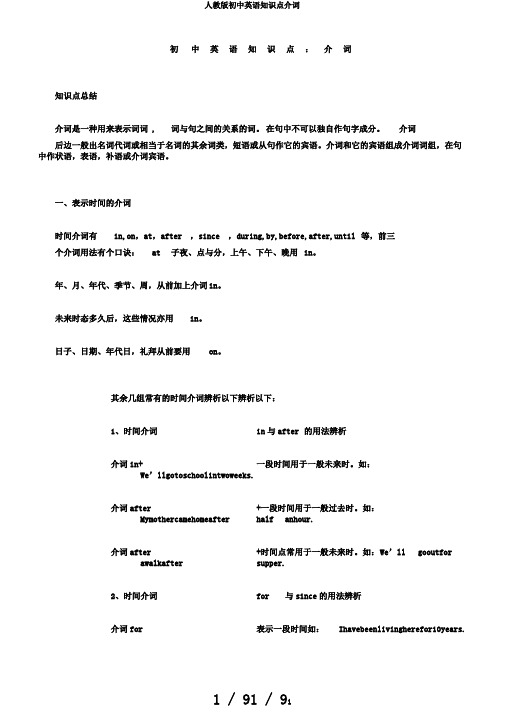
初中英语知识点:介词知识点总结介词是一种用来表示词词 , 词与句之间的关系的词。
在句中不可以独自作句字成分。
介词后边一般出名词代词或相当于名词的其余词类,短语或从句作它的宾语。
介词和它的宾语组成介词词组,在句中作状语,表语,补语或介词宾语。
一、表示时间的介词时间介词有in,on,at,after ,since ,during,by,before,after,until 等,前三个介词用法有个口诀:at 子夜、点与分,上午、下午、晚用in。
年、月、年代、季节、周,从前加上介词in。
未来时态多久后,这些情况亦用in。
日子、日期、年代日,礼拜从前要用on。
其余几组常有的时间介词辨析以下辨析以下:1、时间介词in与after 的用法辨析介词in+ 一段时间用于一般未来时。
如:We’llgotoschoolintwoweeks.介词after +一段时间用于一般过去时。
如:Mymothercamehomeafter half anhour.介词after +时间点常用于一般未来时。
如:W e’ll gooutforawalkafter supper.2、时间介词for 与since的用法辨析介词for 表示一段时间如:Ihavebeenlivingherefor10years.介词since 表示从过去某一时间以来如:Ihavebeenlivingheresince2000.3、时间介词 before 与by的用法辨析介before 表示“在⋯从前〞如:Hewon’tcomebackbeforefive.介by表示“到⋯止,不于⋯〞如:TheworkmustbefinishedbyFriday.4、介during 与for 的用法辨析当所指的起止清楚用介during 如:Heswimseverydayduringthesummer.假如一段不明确用介for 如:Ihaven’tseenherforyears.5、介till 与until 用法的异同till和until用在必定句中,均可表示“直到⋯止〞,如:Iwillwaittill(until)seveno'clock.till 和until 用在否定句中,均可表示“在⋯从前〞或“直到⋯才〞。
七年级英语介词语法知识点
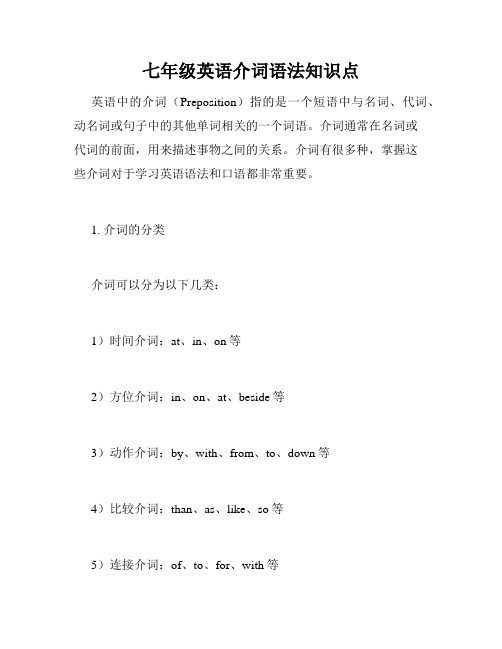
七年级英语介词语法知识点英语中的介词(Preposition)指的是一个短语中与名词、代词、动名词或句子中的其他单词相关的一个词语。
介词通常在名词或代词的前面,用来描述事物之间的关系。
介词有很多种,掌握这些介词对于学习英语语法和口语都非常重要。
1. 介词的分类介词可以分为以下几类:1)时间介词:at、in、on等2)方位介词:in、on、at、beside等3)动作介词:by、with、from、to、down等4)比较介词:than、as、like、so等5)连接介词:of、to、for、with等6)虚拟介词:but、except、save等2. 介词的用法(1)时间介词1)at:用于具体时间点。
如at six o'clock、at night等。
2)in:用于时间段、月份、季节、年份等。
如in the morning、in January等。
3)on:用于特定日期、星期几、节日、具体部分的某一天等。
如on Monday、on Christmas Day等。
(2)方位介词1)in:用于封闭的区域、城市、国家等。
如in the room、in Beijing等。
2)on:用于表面、垂直于表面的东西、街道、公路等。
如on the table、on the wall等。
3)at:用于具体点、建筑物、特殊地名等。
如at the door、at the park等。
4)beside:在……旁边。
如beside the river。
(3)动作介词1)by:靠、在……旁边;用(交通工具)。
如by the river、by bus等。
2)with:和、带着。
如with my friends、with a book等。
3)from:从……来、从……出发。
如from China、from home等。
4)to:向、到达的地方。
如to Beijing、to school等。
5)down:顺着某个方向(向下、向南、向河边等)。
人教版英语七年级常用介词用法

人教版英语七年级常用介词用法七年级英语几个常用介词用法归纳人教版【同步教育信息】一.几个常用介词用法归纳(一)in的用法:1. 表示地点、位置,意思为“在……之中,在……里面”,例如:(1)They often spend holidays in the country. 他们经常在乡下渡假。
(2)The children are playing in the yard. 孩子们在院子里玩耍。
2. 表示时间的范围,意为“在……时候”,如:(3)He gets up at six in the morning. 他早晨6点起床。
(4)The Second World War ended in 1945. 第二次世界大战在1945年结束。
3. 表示时间的经过,意思为“在……之后”,如:(5)Can you finish your work in a day? 你能用一天完成这项工作吗,(6)I’ll call back in ten minutes. 我10分钟后再回电。
4. 表示状况、环境意为“在……状态中,处在……之中”(7)They live in peace. 他们过着平静的生活。
(8)I am in good shape. 我身体状况良好。
5. 穿着,戴着(9)I met a man in glasses there. 我在那遇到一个戴眼镜的人。
(10)That girls is in a red dress today. 那个女孩今天穿着一件红裙子。
(二)on的用法:1. 表示位置,意为“在……之上,在……的表面”,例如:(1)There is a pen on the table. 桌子上有一支笔。
(2)Put it on the shelf. 把它放在书架上。
2. 表示穿戴,附着于(3)She has a hat on her head. 她头上戴着帽子。
(4)Who will put a bell on the cat? 谁能把铃系在猫身上,3. 表示手段,使用……(5)I watched the film on TV. 我在电视上看过那部电影。
初一语法重点介词的用法
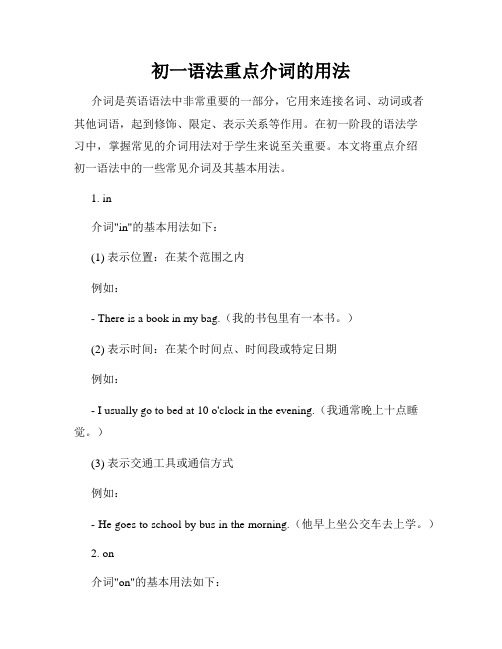
初一语法重点介词的用法介词是英语语法中非常重要的一部分,它用来连接名词、动词或者其他词语,起到修饰、限定、表示关系等作用。
在初一阶段的语法学习中,掌握常见的介词用法对于学生来说至关重要。
本文将重点介绍初一语法中的一些常见介词及其基本用法。
1. in介词"in"的基本用法如下:(1) 表示位置:在某个范围之内例如:- There is a book in my bag.(我的书包里有一本书。
)(2) 表示时间:在某个时间点、时间段或特定日期例如:- I usually go to bed at 10 o'clock in the evening.(我通常晚上十点睡觉。
)(3) 表示交通工具或通信方式例如:- He goes to school by bus in the morning.(他早上坐公交车去上学。
)2. on介词"on"的基本用法如下:(1) 表示位置:在某个平面或表面之上例如:- The book is on the table.(这本书在桌子上。
)(2) 表示时间:在某个准确的时间点例如:- My birthday is on September 2nd.(我的生日在9月2日。
)(3) 表示交通工具或通信方式例如:- I usually communicate with my friends on WeChat.(我通常用微信和朋友们交流。
)3. at介词"at"的基本用法如下:(1) 表示位置:在某个具体的地点例如:- I will meet you at the park.(我会在公园和你见面。
)(2) 表示时间:在某个大致的时间点例如:- We have English class at 9 o'clock.(我们九点有英语课。
)(3) 表示价格例如:- This shirt is on sale at $20.(这件衬衫打折价是20美元。
七年级介词知识点
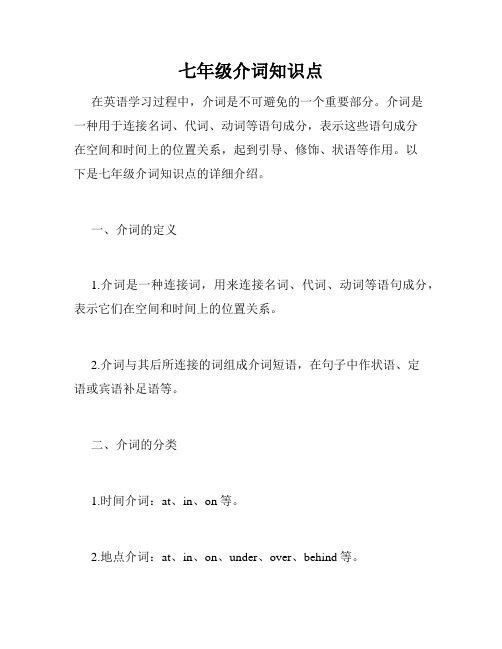
七年级介词知识点在英语学习过程中,介词是不可避免的一个重要部分。
介词是一种用于连接名词、代词、动词等语句成分,表示这些语句成分在空间和时间上的位置关系,起到引导、修饰、状语等作用。
以下是七年级介词知识点的详细介绍。
一、介词的定义1.介词是一种连接词,用来连接名词、代词、动词等语句成分,表示它们在空间和时间上的位置关系。
2.介词与其后所连接的词组成介词短语,在句子中作状语、定语或宾语补足语等。
二、介词的分类1.时间介词:at、in、on等。
2.地点介词:at、in、on、under、over、behind等。
3.方向介词:to、from、into、out of等。
4.方式介词:by、with、without等。
5.原因介词:for、because of、due to等。
6.目的介词:for、to等。
三、时间介词1. at表示具体的时间点,如“at seven o’clock”(七点钟)。
2. in表示时间段,如“in three days”(三天后)、“in July”(七月)。
3. on表示具体的某一天或某一个时间,如“on Sunday”(星期天)、“on July 1st”(七月一号)。
四、地点介词1. at表示某一具体的地点,如“at the bus stop”(在公交车站)。
2. in表示在某一个较大的范围内,如“in the park”(在公园)。
3. on表示在某一物体的表面上,如“on the desk”(在桌子上)。
4. under表示在某一物体的下面,如“under the bed”(床底下)。
5. over表示在某一物体的上面,如“over the roof”(在屋顶上)。
6. behind表示在某一物体的后面,如“behind the door”(在门后)。
五、方向介词1. to表示动向,如“go to school”(去学校)。
2. from表示来自某一地方,如“from Beijing”(来自北京)。
初一英语常见介词用法归纳
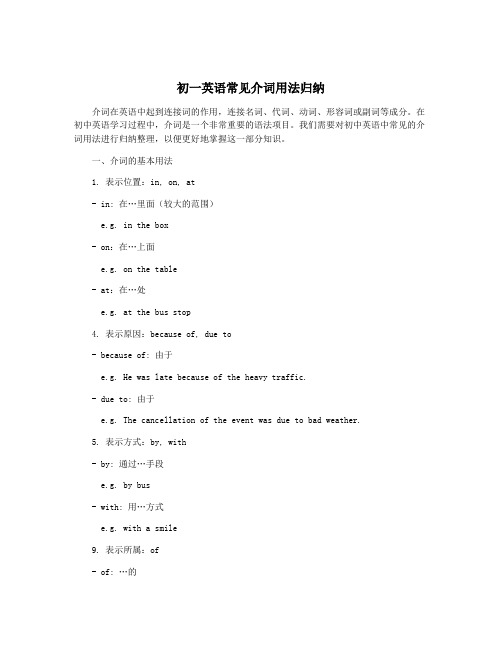
初一英语常见介词用法归纳介词在英语中起到连接词的作用,连接名词、代词、动词、形容词或副词等成分。
在初中英语学习过程中,介词是一个非常重要的语法项目。
我们需要对初中英语中常见的介词用法进行归纳整理,以便更好地掌握这一部分知识。
一、介词的基本用法1. 表示位置:in, on, at- in: 在…里面(较大的范围)e.g. in the box- on:在…上面e.g. on the table- at:在…处e.g. at the bus stop4. 表示原因:because of, due to- because of: 由于e.g. He was late because of the heavy traffic.- due to: 由于e.g. The cancellation of the event was due to bad weather.5. 表示方式:by, with- by: 通过…手段e.g. by bus- with: 用…方式e.g. with a smile9. 表示所属:of- of: …的e.g. the hat of the boy2. look forward to: 期待e.g. I am looking forward to the summer vacation.5. be interested in: 对…感兴趣e.g. Amy is interested in learning Chinese.三、常见介词错误用法及纠正1. 错误用法:depend of正确用法:depend one.g. We depend on each other.通过以上的介词错误用法及纠正,我们可以更清晰地了解该如何正确使用这些介词。
四、综合练习通过上述的综合练习,可以帮助大家更好地掌握介词用法。
七年级英语上册语法专题 介词总结

七年级英语上册语法专题教案介词总结介词用法口诀:早、午、晚要用in,at 黎明、午夜、点与分。
年、月、季节、周,阳光、灯、影、衣、冒in。
将来时态in...以后,小处at 大处in。
有形with 无形by,语言、单位、材料in。
特征、方面与方式,心情成语惯用in。
介词at 和to 表方向,攻击、位置、恶、善分。
日子、日期、年月日,星期加上早、午、晚,收音、农场、值日on,关于、基础、靠、著论。
着、罢、出售、偷、公、假,故意、支付、相反,准。
特定时日和“一……就”,on 后常接动名词。
年、月、日加早、午、晚,of 之前on 代in。
步行、驴、马、玩笑on,cab出租马车,出租汽车,carriage(四轮)马车则用in。
at 山脚、门口、在当前,速、温、日落、价、核心。
工具、和、同随with,具有、独立、就、原因。
就……来说宾译主,对、有、方状、表细分。
海、陆、空、车、偶、被by,单数、人类know to man。
this、that、tomorrow,yesterday,next、last、one。
接年、月、季、星期、周,介词省略已习惯。
over、under正上下,above、below 则不然,若与数量词连用,混合使用亦无关。
beyond 超出、无、不能,against 靠着,对与反。
besides,except 分内外,among 之内along 沿。
同类比较except,加for 异类记心间。
原状because of、owing to有负于,受恩于;应归功于(to)、due to应归于;起因于……,由于(to) 表语形容词under后接修、建中,of、from 物、化分。
before、after 表一点, ago、later 表一段。
before 能接完成时,ago 过去极有限。
since 以来during 间,since 时态多变换。
与之相比beside,除了last but one。
复不定for、找、价、原,对、给、段、去、为、作、赞。
初一英语常见介词用法归纳
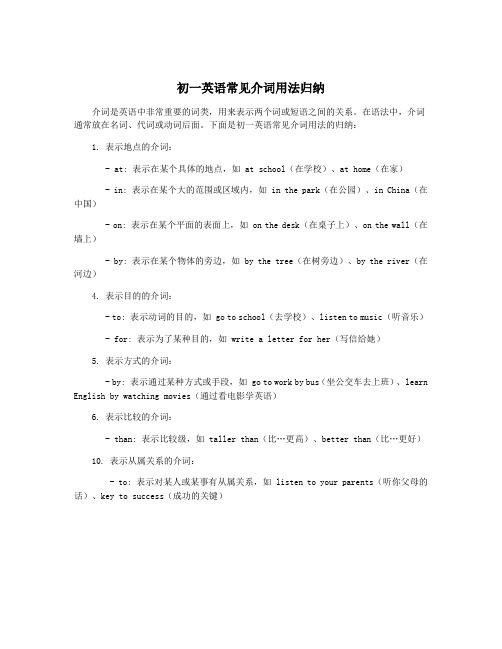
初一英语常见介词用法归纳
介词是英语中非常重要的词类,用来表示两个词或短语之间的关系。
在语法中,介词通常放在名词、代词或动词后面。
下面是初一英语常见介词用法的归纳:
1. 表示地点的介词:
- at: 表示在某个具体的地点,如 at school(在学校)、at home(在家)
- in: 表示在某个大的范围或区域内,如 in the park(在公园)、in China(在中国)
- on: 表示在某个平面的表面上,如 on the desk(在桌子上)、on the wall(在墙上)
- by: 表示在某个物体的旁边,如 by the tree(在树旁边)、by the river(在河边)
4. 表示目的的介词:
- to: 表示动词的目的,如 go to school(去学校)、listen to music(听音乐)
- for: 表示为了某种目的,如 write a letter for her(写信给她)
5. 表示方式的介词:
- by: 表示通过某种方式或手段,如 go to work by bus(坐公交车去上班)、learn English by watching movies(通过看电影学英语)
6. 表示比较的介词:
- than: 表示比较级,如 taller than(比…更高)、better than(比…更好)
10. 表示从属关系的介词:
- to: 表示对某人或某事有从属关系,如 listen to your parents(听你父母的话)、key to success(成功的关键)。
(完整版)人教版七年级上册易混介词in,on,at用法总结及练习.doc

人教版七年上册易混介用法及1、表示的介。
1)at 用于表示刻、的某一点at lunch 在午餐at dawn 在黎明at noon正午at that time 那at night 在夜at the moment此刻,目前at present目前at 9 o’clock 在九点at first 起初,开始的候at/on the weekend在周末at last 最后at the same time同at times 偶,有at the Spring Festival在春2)on 用于表示某天,某一天的上、下午on Monday 在周一on a cold night 在一个寒冷的夜晚on Tuesday morning在周二早上on a New Year’s Eve 在除夕on your birthday 在你生日那天on the morning of National Day 在国的上午on August 8,2008在 2008 年 8 月 8 日on the Children’s Day 在儿童那天on a fine morning 在一个晴朗的早晨on the morning of July first 在 7 月 1 日的早上3)in 用于表示月、季、年前。
in January在一月in the morning/afternoon/evening 在上午 /下午 /晚上in autumn 在秋季in the 21st century 在 21 世in 2013 在 2013 年in September,2012在 2012 年 9 月2、表示所、方向的介。
1)at 表示在某地点 (小地点 )at the school gate在学校口at the door 在at home在家at the airport 在机at the party 在聚会上at the bus stopz在公共汽站at the end of在⋯⋯末尾at my desk 在我的桌旁2)in 表示在某地(大地点);可表示在⋯⋯里。
初一英语语法-介词
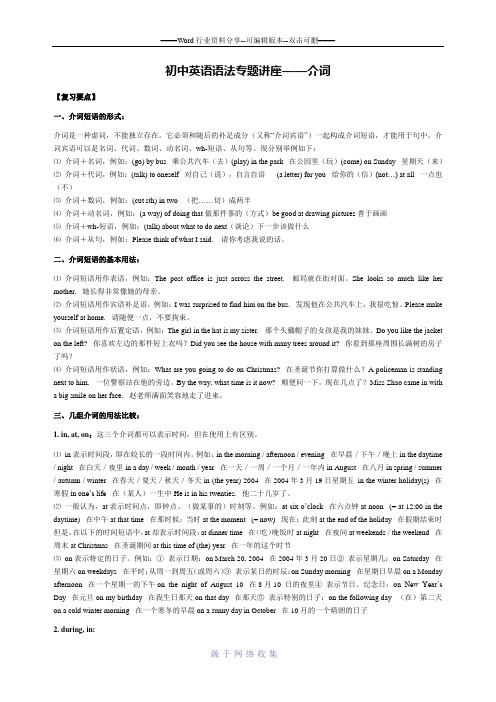
初中英语语法专题讲座——介词【复习要点】一、介词短语的形式:介词是一种虚词,不能独立存在。
它必须和随后的补足成分(又称“介词宾语”)一起构成介词短语,才能用于句中。
介词宾语可以是名词、代词、数词、动名词、wh-短语、从句等。
现分别举例如下:⑴介词+名词,例如:(go) by bus 乘公共汽车(去)(play) in the park 在公园里(玩)(come) on Sunday 星期天(来)⑵介词+代词,例如:(talk) to oneself 对自己(说),自言自语(a letter) for you 给你的(信)(not…) at all 一点也(不)⑶介词+数词,例如:(cut sth) in two (把……切)成两半⑷介词+动名词,例如:(a way) of doing that 做那件事的(方式)be good at drawing pictures善于画画⑸介词+wh-短语,例如:(talk) about what to do next(谈论)下一步该做什么⑹介词+从句,例如:Please think of what I said. 请你考虑我说的话。
二、介词短语的基本用法:⑴介词短语用作表语,例如:The post office is just across the street. 邮局就在街对面。
She looks so much like her mother. 她长得非常像她的母亲。
⑵介词短语用作宾语补足语,例如:I was surprised to find him on the bus. 发现他在公共汽车上,我很吃惊。
Please make yourself at home. 请随便一点,不要拘束。
⑶介词短语用作后置定语,例如:The girl in the hat is my sister. 那个头戴帽子的女孩是我的妹妹。
Do you like the jacket on the left? 你喜欢左边的那件短上衣吗?Did you see the house with many trees around it? 你看到那座周围长满树的房子了吗?⑷介词短语用作状语,例如:What are you going to do on Christmas? 在圣诞节你打算做什么?A policeman is standing next to him. 一位警察站在他的旁边。
七年级介词的用法归纳
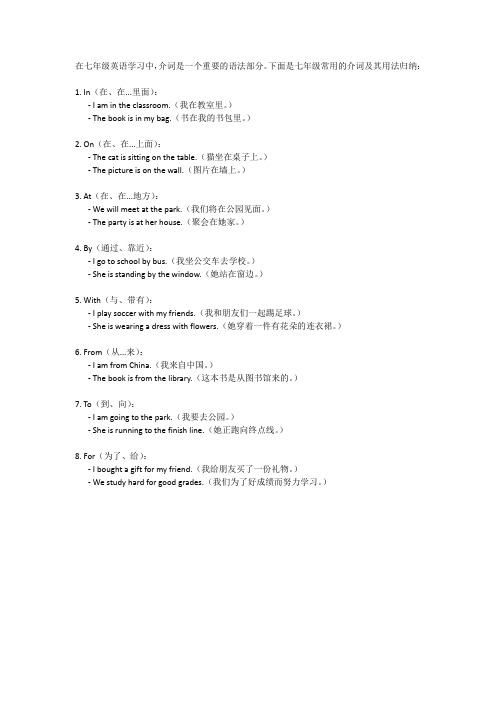
在七年级英语学习中,介词是一个重要的语法部分。
下面是七年级常用的介词及其用法归纳:1. In(在、在...里面):- I am in the classroom.(我在教室里。
)- The book is in my bag.(书在我的书包里。
)2. On(在、在...上面):- The cat is sitting on the table.(猫坐在桌子上。
)- The picture is on the wall.(图片在墙上。
)3. At(在、在...地方):- We will meet at the park.(我们将在公园见面。
)- The party is at her house.(聚会在她家。
)4. By(通过、靠近):- I go to school by bus.(我坐公交车去学校。
)- She is standing by the window.(她站在窗边。
)5. With(与、带有):- I play soccer with my friends.(我和朋友们一起踢足球。
)- She is wearing a dress with flowers.(她穿着一件有花朵的连衣裙。
)6. From(从...来):- I am from China.(我来自中国。
)- The book is from the library.(这本书是从图书馆来的。
)7. To(到、向):- I am going to the park.(我要去公园。
)- She is running to the finish line.(她正跑向终点线。
)8. For(为了、给):- I bought a gift for my friend.(我给朋友买了一份礼物。
)- We study hard for good grades.(我们为了好成绩而努力学习。
)。
人教版七年级上册语法总结:介词
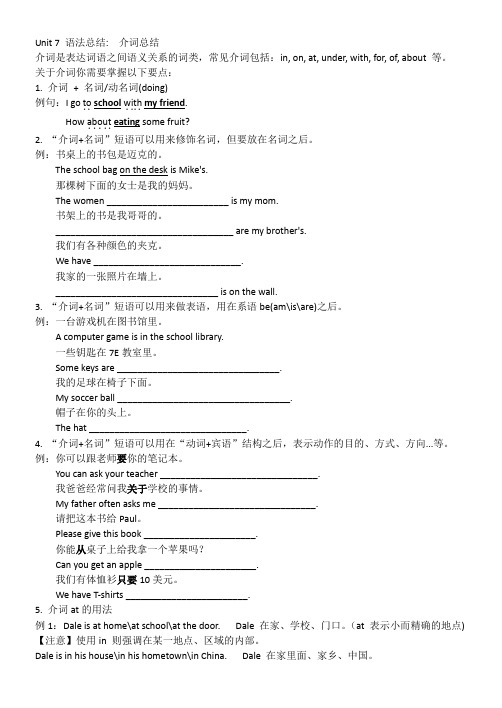
Unit 7 语法总结: 介词总结介词是表达词语之间语义关系的词类,常见介词包括:in, on, at, under, with, for, of, about 等。
关于介词你需要掌握以下要点:1. 介词+ 名词/动名词(doing)例句:I go to..school with....my friend.How about.....eating some fruit?2. “介词+名词”短语可以用来修饰名词,但要放在名词之后。
例:书桌上的书包是迈克的。
The school bag on the desk is Mike's.那棵树下面的女士是我的妈妈。
The women ________________________ is my mom.书架上的书是我哥哥的。
___________________________________ are my brother's.我们有各种颜色的夹克。
We have _____________________________.我家的一张照片在墙上。
________________________________ is on the wall.3. “介词+名词”短语可以用来做表语,用在系语be(am\is\are)之后。
例:一台游戏机在图书馆里。
A computer game is in the school library.一些钥匙在7E教室里。
Some keys are ________________________________.我的足球在椅子下面。
My soccer ball __________________________________.帽子在你的头上。
The hat _______________________________.4. “介词+名词”短语可以用在“动词+宾语”结构之后,表示动作的目的、方式、方向...等。
人教版七年级上册英语语法整理(人教版)
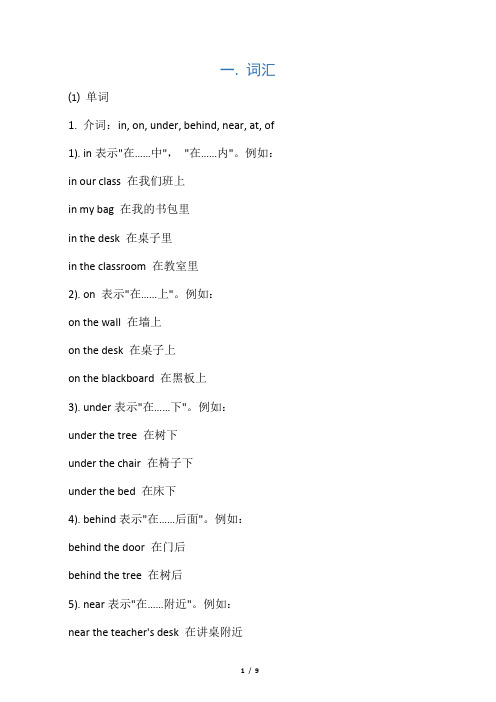
一. 词汇⑴单词1. 介词:in, on, under, behind, near, at, of 1). in表示"在……中","在……内"。
例如:in our class 在我们班上in my bag 在我的书包里in the desk 在桌子里in the classroom 在教室里2). on 表示"在……上"。
例如:on the wall 在墙上on the desk 在桌子上on the blackboard 在黑板上3). under表示"在……下"。
例如:under the tree 在树下under the chair 在椅子下under the bed 在床下4). behind表示"在……后面"。
例如:behind the door 在门后behind the tree 在树后5). near表示"在……附近"。
例如:near the teacher's desk 在讲桌附近near the bed 在床附近6). at表示"在……处"。
例如:at school 在学校at home 在家at the door 在门口7). of 表示"……的"。
例如:a picture of our classroom 我们教室的一幅画a map of China 一张中国地图2. 冠词a / an / the:冠词一般位于所限定的名词前,用来署名名词所指的人或事物。
冠词有不定冠词和定冠词两种。
不定冠词有两个形式,即a和an。
a用在以辅音音素开头的词前,如a book; an用在以元音音素开头的字母前,如an apple.a或an与可数名词单数连用,泛指某类人或某物中的一个。
This is a cat.这是一只猫。
It's an English book.这是一本英语书。
初一上册英语介词知识点归纳

初一上册英语介词知识点归纳初一上册的英语内容并不多,而且都是比较容易掌握的基础知识,只要认真上课就能学好。
以下是店铺分享给大家的初一上册英语介词知识点,希望可以帮到你!初一上册英语介词知识点一、表示时间的介词时间介词有in , on,at,after,since,during,by,before,after,until等,前三个介词用法有个口诀:at午夜、点与分,上午、下午、晚用in。
年、月、年月、季节、周,之前加上介词in。
将来时态多久后,这些情形亦用in。
日子、日期、年月日,星期之前要用on。
其余几组常见的时间介词辨析如下辨析如下:1、时间介词in与after 的用法辨析介词 in + 一段时间用于一般将来时。
如:We’ll go to school in two weeks.介词after + 一段时间用于一般过去时。
如:My mother came home after half an hour.介词after + 时间点常用于一般将来时。
如:We’ll go out for a walk after supper.2、时间介词for与since的用法辨析介词for 表示一段时间如:I have been living here for 10 years.介词since 表示从过去某一时间以来如:I have been living here since 2000.3、时间介词before与by的用法辨析介词before表示“在…之前”如:He won’t come back before five .介词by表示“到…时为止,不迟于…”如:The work must be finished by Friday.4、时间介词during与for的用法辨析当所指的时间起止分明时用介词during如:He swims every day during the summer.如果一段时间不明确则用介词for如:I haven’t seen her for years.5、时间介词till与until用法的异同till和until用在肯定句中,均可表示“直到…为止”,如:I will wait till(until)seven o'clock.till和until用在否定句中,均可表示“在…以前”或“直到…才”。
人教版七年级上册英语语法整理
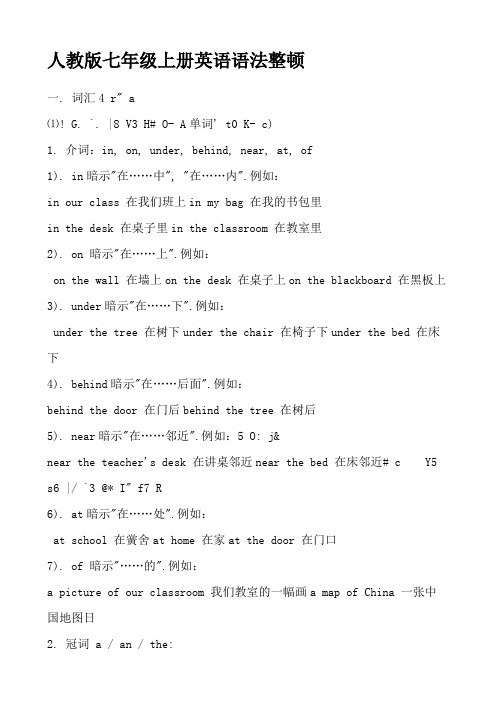
人教版七年级上册英语语法整顿一. 词汇4 r" a⑴! G. `. |8 V3 H# O- A单词' t0 K- c)1. 介词:in, on, under, behind, near, at, of1). in暗示"在……中", "在……内".例如:in our class 在我们班上in my bag 在我的书包里in the desk 在桌子里in the classroom 在教室里2). on 暗示"在……上".例如:on the wall 在墙上on the desk 在桌子上on the blackboard 在黑板上3). under暗示"在……下".例如:under the tree 在树下under the chair 在椅子下under the bed 在床下4). behind暗示"在……后面".例如:behind the door 在门后behind the tree 在树后5). near暗示"在……邻近".例如:5 O: j&near the teacher's desk 在讲桌邻近near the bed 在床邻近# c Y5 s6 |/ `3 @* I" f7 R6). at暗示"在……处".例如:at school 在黉舍at home 在家at the door 在门口7). of 暗示"……的".例如:a picture of our classroom 我们教室的一幅画a map of China 一张中国地图日2. 冠词 a / an / the:冠词一般位于所限制的名词前,用来签名名词所指的人或事物.冠词有不定冠词和定冠词两种.不定冠词有两个情势,即a和an.a用在以子音音素开首的词前,如a book; an用在以元音音素开首的字母前,如an apple.a或an与可数名词单数连用,泛指某类人或某物中的一个.This is a cat.这是一只猫.It's an English book. 这是一本英语书.His father is a worker.他的爸爸是个工人.the既可以用在可数名词前,也可以用在不成数名词前,暗示某个或某些特定的人或事物,也可以指上文提到过的人或事物.Who's the boy in the hat? 戴帽子的男孩是谁呀?-- What can you see in the classroom?-- 你能在教室里看到什么呀?-- I can see a bag. -- 我能看见一个书包.-- Where's the bag? -- 书包在哪呀?9 x-- It's on the desk.-- 在桌子上.①在肯定句顶用some.例如:There are some books on the desk.桌子上有一些书.Lucy has some good books露西有一些好书.②在疑问句和否认句顶用any.例如:Is there any ink in your pen?你的钢笔里有墨水吗?Do you have any brothers and sisters?你有兄弟姐妹吗?There isn't any water in the glass.杯子里没有水.⑵记住它们的特别用法.①some亦可用于暗示愿望得到对方肯定的答复或暗示建议.委婉要求的疑问句中,这一点我们不久就会学到.例如:Would you like to have some apples?你想吃苹果吗?②any也可用于肯定句中,暗示"任何的".例如:Any one of us can do this.我们当中任何一个都能做这个.some 和any的用法是经常消失的考点,愿望大家能精确地控制它们的用法.4.familyfamily看作为一个整体时,意思是"家庭",后面的谓语动词be用单数情势is ;如把family看作为家庭成员时,应懂得为复数,后面的谓语动词be运用are.My family is a big family. 我的家庭是个大家庭.My family are all at home now. 我的家人如今都在家.Family强调由家人构成的一个集体或强调这个集体中的成员.home指小我出生.被抚育长大的情形和栖身地点. house指"家"."衡宇",着重栖身的建筑本身.His family are all workers. 他的家人都是工人My home is in Beijing. 我的家在北京.He isn't at home now. 他如今不在家.It's a picture of my family. 这是一张我全家的照片.5. little的用法+a little dog 一只小狗,a little boy 一个小男孩.little经常运用来润饰有性命的名词.*但little还可暗示否认意义,意为"少的",加不成数名词.There is little time. 几乎没时光了.There is little water in the cup. 杯中水很少.⑵词组on the desk 在桌子上1 Zbehind the chair 在椅子后under the chair在椅子下面in her pencil-box 在她的铅笔盒中near the door 在门邻近a picture of a classroom 一个教室的图片look at the picture 看这张图片the teacher's desk 讲桌a map of China 一张中国地图family tree 家谱have a seat 坐下,就坐this way 这边走二. 日经常运用语1. Come and meet my family.2. Go and see. I think it's Li Lei.3. Glad to meet you.4. What can you see in the picture? I can see a clock / some books.5. Can you see an orange? Yes, I can. / No, I can't.6. Where's Shenzhen? It's near Hong Kong.7. Let me see.(白话)让我想想看.see 在这是"明确.懂了",不成译作"看见".For example :8. Please have a seat. seat暗示"座位",是个名词.have a seat暗示"就坐",也可以说take a seat, 和sit down的意思雷同.三. 语法1. 名词所有格名词如要暗示与后面名词的所有关系,通经常运用名词所有格的情势,意为"……的".一般有以下几种情势(1). 一般情形下在词尾加"'s".例如Kate's father Kate的爸爸my mother's friend 我妈妈的同伙(2). 假如复数名词以s结尾,只加"'".例如Teachers' Day 教师节The boys' game 男孩们的游戏(3). 假如复数名词不以s结尾,仍加"'s".例如:Children's Day 儿童节Women's Day 妇女节(4). 暗示两个或几个共有时,所有格应加在后一个名词上.例如:Lucy and Lily's room Lucy 和Lily的房间Kate and Jim's father Kate 和Jim的爸爸w动物和无性命事物的名词的所有格一般不在词尾加"'s",而经经常运用介词of的短语来暗示.a map of China 一幅中国地图the name of her cat 她的猫的名字a picture of my family 我的家庭的一张照片the door of the bedroom 卧房的门2. 祈使句祈使句重要用来暗示措辞人的要求.敕令.建议.吩咐等意图.祈使句一般不必主语,读时用降调.为使语气委婉.礼貌,常在句首或句尾加please .在句尾时,please前多用逗号.(1). 祈使句肯定情势的谓语动词一律用动词本相. Go and see. 去看看.Come in, please. 请进.(2). 祈使句的否认情势经常运用don't于句首Don't look at your books. 不要看书.Don't play on the road. 不要在马路上玩.3. There be 的句子构造There be是一个"消失"句型,暗示"有"的意思,肯定句的情势为:There be + 名词(单数或复数)+地点状语或时光状语.be动词单复数的肯定,看be后边第一个名词,当所接主语为单数或不成数名词时,be动词情势为is;当所接主语为复数名词时,be动词为are;当be动词后接两个以上主语时,be动词与最邻近主语保持数上的一致.意思为"某地有或人或某物".如:There is an eraser and two pens on the desk. 桌子上有一块橡皮和两支钢笔.There are two pens and an eraser on the desk. 桌上有两支钢笔和一块橡皮.(1)there be的否认句,即在be的后面加上not.否认情势为:There be + not + (any) + 名词+地点状语.There is not any cat in the room. 房间里没猫.There aren't any books on the desk. 桌子上没书.(2)there be句型的疑问句就是将be提到句首:Be there + (any) +名词+地点状语?肯定答复:Yes, there is / are. 否认答复:No, there isn't / aren't.---Is there a dog in the picture? 画上有一只狗吗?---Yes, there is. 有.---Are there any boats in the river? 河里有船吗?---No, there aren't. 没有.(3)特别疑问句:How many . . . are there (+地点状语)?"某地有若干人或物?"答复用There be . . .There's one. / There are two / three / some . . .有时直接就用数字来答复.One. / Two . . .---How many students are there in the classroom? 教室里有若干学生?---There's only one. / There are nine. 只有一个./有九个.(4)假如名词是不成数名词,用:How much + 不成数名词 + is there + 地点状语?How much water is there in the cup? 杯中有若干水?How much food is there in the bowl? 碗里有若干食物?。
初一年级英语语法 介词的用法 语法讲解 (共27张PPT)

但: on the morning of May 1st
6. in the day = in the _d_a_y_-_ti_m__e
1. Mary is flying to France soon. She will arrive in Paris ___ the morning of July 9. A. on B. in C. at
4. We finish our lessons ___ 11:30 and then have a rest __ noon. A. in , in B. at ,at C. in, at
其他表示时间的介词
in + 时间段 在……之后(内), 多用于将来时 after +时间段 在……之后, 多用于过去时 1). Mr. Brown has gone to Canada. He will be back ___ two weeks.
8. We have sweaters at a very good price — only 25 dollars.在;以
9. For breakfast, he likes eggs, bananas and apples. 对于
其他介词
10. The temperature(温度) will fall below zero at night.
2. The twins were born __ a Friday evening. A. in B. on C. at
3. We travelled overnight to Paris and arrived __5 o’clock __ the morning. A. on, in B. at, in C. at, on
人教版七年级英语上册语法点——介词

七年级英语上册语法点6——介词1.in; on;at用在时间词前,表“在”1)at + 具体时刻2)on + 具体某天(具体某天的上、下午等;星期词;以及上、下午词前有修饰词时)3)in + 年、月、季节及一天中的某部分但注意:at night=inthe night atnoonat this /that time at Christmaseg.1.___the morning2.___Monday morning3. ___ arainy evening4.___3:50 5.__ 20026.___ the morning ofApril 107.___ spring8.___ night 9.___this time 10. ___March另外注意:在时间词(morning , afternoon , evening; Sunday…)前有last, next , this ,that时,不再用介词. tomorrow,tonight前也不用介词。
eg. I willgo(A)to the cinema(B)in(C)this evening.2.in, on,at表地点:at一般指小地方;in一般指大地方或某个范围之内;on往往表示“在某个物体的表面”。
例如:eg.1)He arrived___Shanghai yesterday.2)They arrived___asmall village before dark.3)There is a big hole ____the wall.4)The teacherput upapicture____ the wall.3.in,on, to表方位in(范围内);on(范围外且接壤);to(范围外但不接壤)。
可表示为下图的位置关系eg.1)Taiwan is in the southeastof China.2)Hubei is on the north ofHunan.3)Japan is to theeast ofChina.cross: 动词“跨过,越过”=go across4.across:(表面)跨过through:(内部)穿过,贯穿介词eg. 1)Can you swim _____ the river?2)The road runs __________ the forest.3) _____the bridge,you’ll find a cinema.5. in+ 时间段:与将来时连用after +时间段:与过去时连用但after +时间点:可与将来时连用。
- 1、下载文档前请自行甄别文档内容的完整性,平台不提供额外的编辑、内容补充、找答案等附加服务。
- 2、"仅部分预览"的文档,不可在线预览部分如存在完整性等问题,可反馈申请退款(可完整预览的文档不适用该条件!)。
- 3、如文档侵犯您的权益,请联系客服反馈,我们会尽快为您处理(人工客服工作时间:9:00-18:30)。
七年级英语上册语法点6——介词
1.in; on; at用在时间词前,表“在”
1)at + 具体时刻
2)on + 具体某天(具体某天的上、下午等;星期词;以及上、下午词前有修饰词时)
3)in + 年、月、季节及一天中的某部分
但注意:at night= in the night at noon
at this / that time at Christmas
eg. 1.___ the morning 2.___ Monday morning
3. ___ a rainy evening
4. ___3:50
5.__ 2002
6.___ the morning of April 10
7.___ spring
8.___ night 9.___ this time 10. ___ March
另外注意:在时间词(morning , afternoon , evening ; Sunday…)前有last, next , this , that时,不再用介词. tomorrow, tonight前也不用介词。
eg. I will go(A) to the cinema(B) in(C) this evening.
2. in , on , at 表地点:
at一般指小地方;in一般指大地方或某个范围之内;on往往表示“在某个物体的表面”。
例如:
eg. 1)He arrived ___Shanghai yesterday.
2)They arrived ___a small village before dark.
3)There is a big hole ____ the wall.
4)The teacher put up a picture ____ the wall.
3.in , on , to表方位
in(范围内);on(范围外且接壤);to(范围外但不接壤)。
可表示为下图的位置关系
eg.1)Taiwan is in the southeast of China.
2)Hubei is on the north of Hunan.
3)Japan is to the east of China.
cross: 动词“跨过,越过”=go across
4. across: (表面)跨过
through: (内部)穿过,贯穿介词
eg. 1)Can you swim _____ the river?
2)The road runs __________ the forest.
3) _____ the bridge, you’ll find a cinema.
5. in + 时间段:与将来时连用
after + 时间段:与过去时连用
但after + 时间点:可与将来时连用。
1) I’ll leave _______ three o’clock.. That is, I’ll leave ________ about ten minutes.
2)They left _______ two weeks.
6. in the tree(外加在树上的事物)
on the tree(树上自身具有的花、果、叶等)
in the wall(镶嵌在墙内部的事物)
7. on the wall(墙表面的事物)
1) There is a map ___ the wall
2) There are four windows ___ the wall.
8.by bike / bus / car / ship (单数且无冠词)
但当这些交通工具名词前有其它修饰词时,则应使用相应的介词。
eg. by bike = on a(the; his) bike
by car = in a(the ; her) car
on: 在…(表面)上——接触
9. over: 在…的正上方
above: 在…的斜上方未接触
1) The moon rose ______ the hill.
2) There is a bridge _____ the river.
3) There is a book ______ the desk.
10. between: 在(两者)之间
among :在(三者以上)之间
1)A big crowd of people were waiting for Li Lida on the beach. ________ them were his parents.
2)Tom sits ________Lucy and Lily.
11.on与about : 关于
on用于较正式的演讲、学术、书籍等
about用于非正式的谈话或随便提及
eg. He gave a talk ____ the history of the Party
12. in front of :在…前面/方(范围外)= before
in / at the front of:在……前部(范围内)
1)There is a big tree _______ of the classroom.
2)A driver drives _________ of the bus.
类似区别:at the back of与behind
13.with和in: 表示“用“
with: 指“用工具、手、口等”
in: 指“用语言、话语、声音等”
1) Please write the letter ____ a pen.
2) Please speak ____ a loud voice.
14. on a farm ; in a factory ; the girl in the hat ; leave for: 动身前往某地
15.一些固定搭配:
(1)介词与动词的搭配
listen to , laugh at, get to, look for;
wait for, hear from, turn on, turn off, worry about, think of, look after, spend…on…, 等。
(2)介词与名词的搭配
on time, in time, by bus, on foot,
with pleasure, on one’s way to, in trouble,
at breakfast, at the end of, in the end等。
(3)介词与形容词的搭配
be late for, be afraid of, be good at,
be interested in, be angry with,
be full of, be sorry for等。
二、常见方位介词短语
(一)、由介词in构成的方位介词短语
1、in the front 在前面
2、in the front row 在前排
3、in the back row 在后排
4、in the third row 在第三排
5、in front of... 在...前面(范围之外)
6、in the front of... 在...前部(范围之内)
7、in the middle在中间
8、in the street在街上
9、in the middle of...在中间10、in the tree在树上(指飞鸟等外来物)
(二)、由介词at构成的方位介词短语
1、at the front of...在...所在范围的前一部分
2、at the back of...在...所在范围的后一部分
3、at the foot of...在...脚下
4、at the top of...在...顶部
5、at the end of...在...尽头
6、at the head of...在...前头
7、at the(school)gate在(校)门口8、at the station 在车站
9、at No.2 Chang’an Road在长安路2号10、at my uncle’s 在我叔叔家11、at home在家12、at the doctor’s在医务室/在诊所
(三)、由介词on构成的方位介词短语
1、on the right/left在右(左)边
2、on one’s right/left在某人的右(左)边
3、on the desk/table在课桌/桌上
4、on the right-hand/left-hand side 在右/左手边
5、on the blackboard在黑板上
6、on/in the wall在墙上/里
7、on the paper在纸上8、on the tree在树上(指树上长的,结的东西)
三、其它介词构成的方位介词短语
1、next to靠近/贴近
2、beside the desk在课桌旁
3、behind the door在门后
4、under the bed在床下
5、near the window靠近窗户
6、outside the gate在门外。
